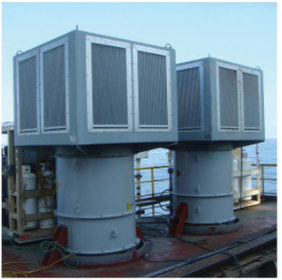A louver is a basic component of any industrial ventilation system. It permits air to flow from one side of an opening in a wall, plenum, or bulkhead to the other side. In this blog, I’ll cover the louver fundamentals including louver construction, functions, and technology.
Construction
Louver blades are stationary and are placed within a frame that has two vertical sides called jambs. The horizontal top piece is referred to as the head. The horizontal bottom piece is called the sill. In some cases, additional vertical pieces, called mullions, may be added between the jambs if the louver is particularly wide.
A louver’s size and shape can vary. When dealing with a square or rectangular louver, the dimensions are always specified as Width x Height x Depth. The Width refers to the dimension that runs parallel to the louver’s horizontal head and sill.
Industrial louvers can be made from extruded aluminum and come with an anodized finish. They can also be constructed from hot rolled steel, galvanized steel, or stainless steel, depending on their intended use.
Functions
The primary function of a louver in any industrial ventilation system is to allow airflow into or out of a ventilated space. That means that louvers can be used as either the supply air or exhaust air component in a ventilation system. When man or truck door openings won’t provide sufficient supply or exhaust airflow, louvered opening are used to provide airflow balance.
The feature that makes a louver so important is its ability to prevent water from entering the ventilated space. This is critical when the louver is used as the supply air component. But it can also be important when used as the exhaust air component to prevent water from entering when the fans are not operating.
How a louver prevents water egress is determined by the orientation and design of the louver blades. I’ll discuss this more in the technology section of this blog. Another factor in preventing water egress is the velocity of the airflow through the louver. That makes sizing the louver for sufficient airflow a critical part of any ventilation system design.
 In some cases, louvers can have a secondary function. If air volume control is also a requirement, a louver can be constructed with adjustable blades that can be manually or mechanically controlled. Another secondary function may be noise control. Acoustic louvers can work to prevent noise from entering or leaving the ventilated space. Lastly, louvers may require an aesthetic function. Architectural louvers are designed to perform their primary function and to look good from the outside of the building.
In some cases, louvers can have a secondary function. If air volume control is also a requirement, a louver can be constructed with adjustable blades that can be manually or mechanically controlled. Another secondary function may be noise control. Acoustic louvers can work to prevent noise from entering or leaving the ventilated space. Lastly, louvers may require an aesthetic function. Architectural louvers are designed to perform their primary function and to look good from the outside of the building.
Technology
The advancement of louver design and technology has led to the emergence of unique types of louvers. An instance of this is the horizontal drainable blade louver. The unique blade design captures water in the airflow. The horizontal blades have small gutters on the bottom edges. They redirect rainwater to downspouts located in the jambs. This results in a more water-resistant louver, while still retaining the classic appearance of horizontal blades.
A new improvement to louvers is the acoustic louver. It merges the characteristics of a standard horizontal blade louver with sound-reducing treatments. The use of a chevron blade design and noise reduction treatment in an acoustic louver creates a complete obstruction in the line of sight. This causes a redirection of airflow and provides optimal noise reduction for critical applications.
 Eldridge specializes in cutting-edge louver technology. Our heavy-duty Vertical Storm Louver is constructed with anodized, extruded aluminum. It is designed to be used with our patented Eldridge Storm Guard Hoods. Unlike traditional louvers, the blades in the Vertical Storm Louver are oriented vertically. This unique design, coupled with the closely spaced blades and internal features, allows the 6″ deep louvers to block 99.9% of rain at a rate of 14″ per hour and 50 MPH winds. For even more extreme weather conditions, our 12″ deep model can withstand rainfall of 30″ per hour and winds of 110 MPH.
Eldridge specializes in cutting-edge louver technology. Our heavy-duty Vertical Storm Louver is constructed with anodized, extruded aluminum. It is designed to be used with our patented Eldridge Storm Guard Hoods. Unlike traditional louvers, the blades in the Vertical Storm Louver are oriented vertically. This unique design, coupled with the closely spaced blades and internal features, allows the 6″ deep louvers to block 99.9% of rain at a rate of 14″ per hour and 50 MPH winds. For even more extreme weather conditions, our 12″ deep model can withstand rainfall of 30″ per hour and winds of 110 MPH.
The Vertical Storm Louver is an essential component in air systems and environments. It is used where the infiltration of rain through the louver could pose a risk of electric shock to individuals or cause damage to the protected equipment. It is particularly important in settings such as transformer rooms, engine-generator rooms, air compressor rooms, electrical switchgear rooms, and areas with large electrical motors. Additionally, the Eldridge Vertical Storm Louver can function as a sand louver in critical scenarios. In this application it is highly effectively at eliminating dust and sand particles from the air.
Conclusion
At Eldridge, we enjoy solving the toughest industrial ventilation problems. Our problem-solving solutions create successful environments for people, products and processes. If you have a challenging louver application that goes beyond louver fundamentals, contact an Eldridge ventilation expert and we will find the best louver for your application.
